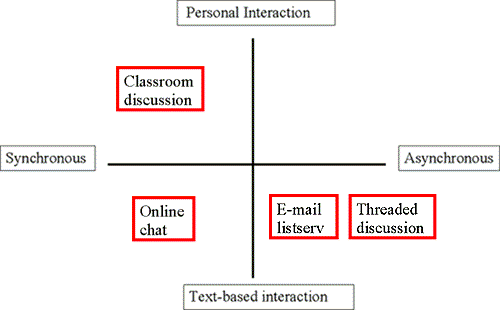Creating Distance Learning Courses
Lesson Three
Using Technology to Encourage Communication
Part 4: Comparing the formats
First, let's
consider the pros and cons of synchronicity, comparing formats on the
left of the graphic above to those on the right side. To my way of thinking,
" synchronous" discussions (e.g. in class and
live chat) have the following disadvantages:-
- participants must have the same schedule;
- discussions tend to be dominated by the students who are quick with
words;
- the flow of the discussion is often controlled by the teacher;
- the organization of the discussion is linear by necessity;
- only one topic can be covered at a time;
- only one voice can be heard at a time; and in my field,
- individuals who with severe communication impairments cannot keep up
with speaking students.
"Asynchronous"
discussions (e.g. threaded discussion, email via listserv) have the following
advantages:
+ it is possible to have multiple topics discussed concurrently
+ students' contributions can be organized by topic
+ students can retain the discussion messages and review them later
+ these discussions encourage participation from more of the students
+ contributions tend to be more thoughtful and more detailed than in class
discussions
+ in my field, individuals with severe communication impairments can participate
equally by taking more time to compose their contributions
Does this mean that in-class discussions are always at a disadvantage? No, of course not. We have to consider the other dimension in our matrix. Let's think now about the nature of the interaction: personal or text-based. Now we are comparing items above the line in the graphic above, to those below the line.
In my experience,
discussions with "personal interaction" (e.g. in-class) have
some distinct advantages and disadvantages:
Advantages:
+ eye contact
+ facial expressions, body language
+ ideas can be demonstrated
+ objects, tools can be shown
+ no set up necessary; can "wing it"
+ no tech support necessary
But they also have....
Disadvantages:
- participants must come to one location at one time
- web resources are harder to utilize effectively
I've also
found some distinct advantages and disadvantages of "text-based interaction"
such as live chat, threaded discussion, email via listserv).
Advantages include:
+ students can participate from many locations
+ web resources are easy to integrate into the discussion
+ can meet people with disabilities/differences and never know they have
disabilities until the individual chooses to reveal it.
But there are disadvantages, too, including:
- misunderstandings are common in text-only communication
- demonstrations cannot accompany the discussions
- text-based interactions are confusing if there are too many participants
- interactions are very long and slow if there are too many participants
- set-up is usually necessary
- tech support is usually necessary before the discussion begins
- communication technology can fail during discussions
- cannot meet people face-to-face
So, we've compared many of the formats on the matrix. So far, we've implied that two of the formats are fairly equivalent— threaded discussion and email via a listserv. They do fall in the same quadrant of the matrix, so they are similar in many ways, but there are some subtle differences I have experienced in my teaching.
Threaded
discussions have some distinct disadvantages that impeded a lively online
discussion in my classes, including:
- participants can participate in discussions only when they actively
log in to the web site. In my experience, this means....
- participants tend to log in only once or twice a week, which means....
- they typically see a large number of messages all at once, which means...
- they often only skim other students contributions and tend to write
only to the instructor
I've had a different experience with email via listserv:
+ the discussion messages are received passively, arriving in email
+ each message is received one-by-one all day, every day
+ participants tend to respond to more messages, more frequently, making
the discussion more lively.
+ participants tend to respond individually to a message, addressing the
student who wrote it
Summary
So, now that we've discussed the pros and cons of these different types of academic discussion, you should begin to think about your own field, the topics you might discuss and the students you would be serving. Take a look again at this matrix,

and think about which method of discussion works best for different topics with different students in your field. We'll have an online discussion shortly about your observations.
